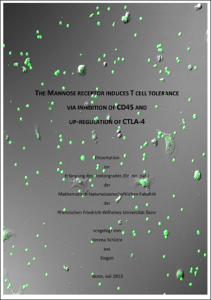The Mannose receptor induces T cell tolerance via inhibition of CD45 and up-regulation of CTLA-4

The Mannose receptor induces T cell tolerance via inhibition of CD45 and up-regulation of CTLA-4

| dc.contributor.advisor | Burgdorf, Sven | |
| dc.contributor.author | Schütte, Verena | |
| dc.date.accessioned | 2020-04-19T20:12:35Z | |
| dc.date.available | 2020-04-19T20:12:35Z | |
| dc.date.issued | 28.03.2014 | |
| dc.identifier.uri | https://hdl.handle.net/20.500.11811/6054 | |
| dc.description.abstract | The present study proves that the mannose receptor (MR) bears beside its function as endocytic receptor a second responsibility namely the induction of tolerance. The results of our experiments show that the decision, whether this immune-suppressive effect is carried out depends on the inflammatory status of the surrounding milieu. Whereas at steady-state conditions the MR has a tolerogenic effect during activation of CD8+ T cells, this suppressive phenotype is overcome under inflammatory conditions. Thereby, the MR resembles a molecular switch between tolerance induction on the one hand and allowance or even mediating immunity by antigen-uptake on the other hand. The investigations of this thesis shed light into the underlying molecular mechanism of the MR-mediated induction of tolerance. The MR on DCs can bind to the tyrosine phosphatase CD45 on the T cell surface. This interaction leads to inhibition of its phosphatase activity, which is responsible for a reduced cytotoxic capacity of activated CD8+ T cells. The executive molecule in this process is the inhibitory protein cytotoxic T-lymphocyte antigen 4 (CTLA-4), being up-regulated upon inactivation of CD45. After maturation of the DCs with the inflammatory molecule CpG, the immune suppressive effect of the MR is overcome and a robust immune response is initiated. The findings of this study pinpoint this effect to the abolished expression of CTLA-4. It is furthermore shown that signaling events via the co-stimulatory molecule CD28 are sufficient to suppress CTLA-4 up-regulation. Hence, a potent cytotoxic CD8+ T cell response is induced. Finally, it can be demonstrated that the tolerogenic effect of the MR as well as its molecular mechanism also holds true in vivo. | en |
| dc.language.iso | eng | |
| dc.rights | In Copyright | |
| dc.rights.uri | http://rightsstatements.org/vocab/InC/1.0/ | |
| dc.subject | Mannose-Rezeptor | |
| dc.subject | Toleranz | |
| dc.subject | Cytotoxicity | |
| dc.subject | IFN-gamma | |
| dc.subject | CTLA4 | |
| dc.subject | CD45 | |
| dc.subject | Mannose receptor | |
| dc.subject | tolerance | |
| dc.subject | Zytotoxizität | |
| dc.subject.ddc | 500 Naturwissenschaften | |
| dc.subject.ddc | 570 Biowissenschaften, Biologie | |
| dc.subject.ddc | 610 Medizin, Gesundheit | |
| dc.title | The Mannose receptor induces T cell tolerance via inhibition of CD45 and up-regulation of CTLA-4 | |
| dc.type | Dissertation oder Habilitation | |
| dc.publisher.name | Universitäts- und Landesbibliothek Bonn | |
| dc.publisher.location | Bonn | |
| dc.rights.accessRights | openAccess | |
| dc.identifier.urn | https://nbn-resolving.org/urn:nbn:de:hbz:5n-35347 | |
| ulbbn.pubtype | Erstveröffentlichung | |
| ulbbn.birthname | Schröder | |
| ulbbnediss.affiliation.name | Rheinische Friedrich-Wilhelms-Universität Bonn | |
| ulbbnediss.affiliation.location | Bonn | |
| ulbbnediss.thesis.level | Dissertation | |
| ulbbnediss.dissID | 3534 | |
| ulbbnediss.date.accepted | 14.10.2013 | |
| ulbbnediss.institute | Mathematisch-Naturwissenschaftliche Fakultät : Fachgruppe Molekulare Biomedizin / Life & Medical Sciences-Institut (LIMES) | |
| ulbbnediss.fakultaet | Mathematisch-Naturwissenschaftliche Fakultät | |
| dc.contributor.coReferee | Kolanus, Waldemar |
Files in this item
This item appears in the following Collection(s)
-
E-Dissertationen (4337)




